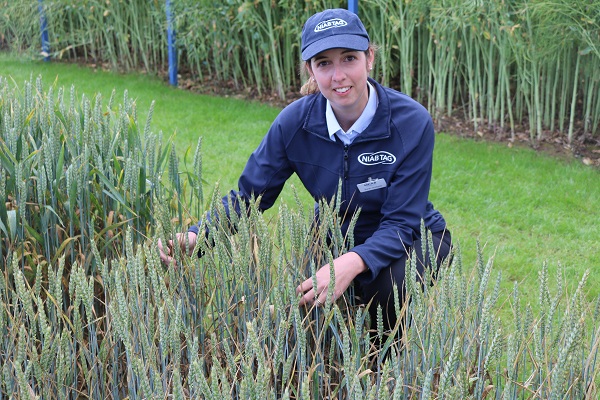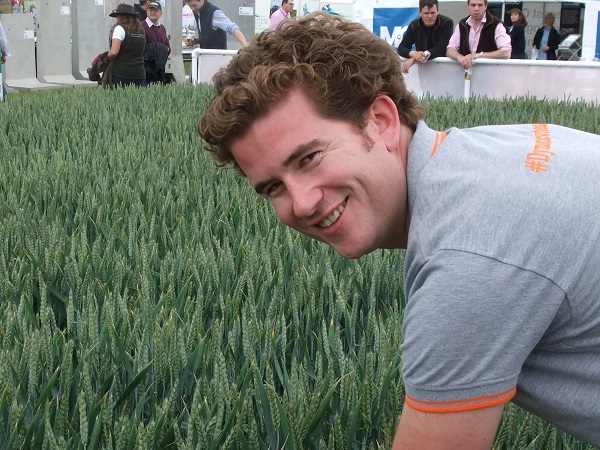A number of new active ingredients were launched at Cereals 2016, but will it keep pace with those that are being removed, and can they turn the tide of farming fortunes? CPM assesses the mood.
At a time when herbicides are being withdrawn we’re excited to be bringing a new active ingredient into the UK
By Tom Allen-Stevens and Lucy de la Pasture
New chemistry was unveiled by Bayer, Dow AgroSciences and Syngenta at Cereals 2016, with some new approvals already in hand and others expected to be gained in the near future. Even better news was that more new products are in the pipeline from all three manufacturers, though none have yet discovered the elusive molecule that will answer the prayers of those afflicted by blackgrass.
Dow AgroSciences introduced Cereals visitors to a brand new molecule, Arylex Active (halauxifen-methyl), first made available in a new product, Pixxaro, approved earlier this year. The company believes its new technology will offer ‘farmer karma’ by simplifying broadleaf weed control.
The new Arylex-branded active is the first molecule to be introduced for broadleaf weed control in the UK for many years. It offers rapid, dependable weed control across the spraying season, almost regardless of the weather, explained Dow AgroSciences’ Alex Nichols.
“Arylex cuts through the traditional limitations associated with other synthetic auxins. It works in cold and warm weather and when weeds are growing fast, slow, or in a stop-start fashion. Quite simply, Arylex Active redefines what a true broad-spectrum weed control product can achieve,” he said.
“At a time when broadleaf weed herbicides, such as HBNs, are being withdrawn we’re excited to be bringing a new active ingredient into the UK.”
Pixxaro contains both Arylex and fluroxypyr, the tried and tested ingredient in Spitfire and Starane products. The combination tackles key weeds such as cleavers, poppy, cranesbill, fumitory, chickweed and fat hen. In trials, Pixxaro has outperformed sulfonylurea products against dead-nettle, fumitory, fat hen, cleavers and volunteer beans, he said.
The application window can start as early as 1 Feb or at growth stage (GS) 13, running up to GS45 (second node visible) in winter-sown crops. For spring cereals, applications commence from 1 March. Recommended application rate is 0.5 l/ha plus an adjuvant in 100-200 l/ha of water using a medium spray quality through a range of nozzle types.
Along with reliability, Pixxaro offers flexibility, pointed out Alex Nichols. “With no ALS chemistry in the product, there are no restrictions on tank-mixing or sequencing and no major following crop restrictions.”
Low use rates, combined with rapid degradation in soil and plant tissues, has given Arylex Active a good profile for crop, environment and operator safety, helping it pass new, stricter EU regulations quickly. Hot on the heels of Pixxaro, another new herbicide containing Arylex and florasulam, suitable for both autumn or spring use, is hoped to be granted approval for use in time for spring 2017.
Syngenta gave visitors a preview of their exciting new SDHI chemistry, trademarked Solatenol, containing benzovindiflupyr. First approved in South America in 2014, the new Syngenta chemistry is currently awaiting the nod from CRD and should be available for use next spring, said Andrew Curtis, fungicide campaign manager.
“This new SDHI will contain Solatenol in combination with prothioconazole. In trials, it’s producing enhanced levels of disease control and, notably, extended green leaf retention over other market-leading SDHI products,” he claimed.
The Syngenta stand featured images of fungal spores taken by an electron microscope which could be viewed in 3D. The images of spores germinating showed the degree of damage fungal hyphae (both yellow rust and septoria) inflict on the cells within the leaf, illustrating that infection causes internal damage and a consequent loss of yield if a curative fungicide treatment is required.
Bayer have two new product approvals, though neither contain novel molecules. Further down the road, the huge Bayer R&D commitment has much needed new chemistry on the way.
A new blackgrass herbicide will be launched as Hamlet this Autumn. Hamlet will give better blackgrass control than Atlantis in wheat, said Phillipa Overson, herbicide campaign manager, estimating an additional 5-10% control when applied as part of the herbicide stack.
“It’s built around mesosulfuron (112.5g) and iodosulfuron (3.75g), but also contains 75g DFF. As well as an increased level of blackgrass control, Hamlet is active on a wider range of broadleaf weeds and has a greater effect on ryegrass than Atlantis,” she said.
Bayer also introduced Ascra Xpro, the first wheat fungicide to contain two SDHI active ingredients – bixafen (65g/l) and fluopyram (65g/l) – in combination with prothioconazole (130g/l).
Rust ratings set to shift
A number of wheat varieties are not living up to their current yellow rust ratings, according to Dr Sarah Holdgate, UK Cereal Pathogen Virulence Survey project manager based at NIAB. It suggests the rust population has taken a shift and that disease scores may need a reshuffle this autumn.

There’s a change in yellow rust afoot, but Sarah Holdgate isn’t sure yet which race is doing the damage.
“We’re finding a number of samples sent in have two races of yellow rust on a single leaf. We’ve seen it before, but it’s becoming more common. It’s clear there’s a change afoot, but quite which race is doing the damage, we need to work on,” she told CPM.
Damage to Reflection has already been widely reported. “We thought at first it was just seedling susceptibility, but it appears from recent assessments that adult plants are also affected. Britannia, Myriad and Zulu have also succumbed.”
But it’s not yet clear which race of yellow rust is primarily responsible for the breakdown. It could be a resurgence of the Kranich race, identified first in 2014, but not found on any samples in 2015. It may be the new pathotype identified last season, or it could be an entirely new race, she said. It could even be the combined effect of two races on a single plant that’s causing the damage.
“We’ll know more once we have the results of inoculated field trials at the end of Aug to early Sept, and can compare these to the isolates that have been sent in,” said Sarah Holdgate. Definitive answers won’t surface until the results of genotyping work carried out by JIC are presented next March.
“When you get a change, it’s not a dramatic drop, however – it’s more gradual, which makes it hard to predict where the yellow rust score will end up,” she added.
“In our work so far, Ascra Xpro has given a clear benefit in disease control over current market-leading products, which has translated into a 0.3t/ha yield advantage,” explained Nick Duncan, cereal fungicide campaign manager. “Ascra Xpro brings faster activity and boosts key disease control, particularly septoria.”
Further down the pipeline, future innovations from Bayer include a new nematicide for root crops and Conviso Smart, a herbicide-tolerant system for weed control in sugar beet being developed in conjunction with KWS.
Tweet to turn tide on pesticide threat
Growers have been urged to harness the power of social media to promote the positive side of pesticides. A quarter

Mike Hambly’s looking to take a different approach to get across the truth on pesticides.
of the active ingredients used in crop production are due to come up for renewal before harvest 2017, noted NFU combinable crops chairman Mike Hambly.
“It started with neonics, then glyphosate, and now there’s a question mark over diquat. Sometimes it feels as though you’re fighting fires.”
There are 67 active ingredients due to expire before harvest 2017, and a further 51 products in the following year, he pointed out. These include pendimethalin, flufenacet, propyzamide, cypermethrin and prothioconazole. A decision is also expected on endocrine disrupters.
“We need to take a different approach to get our case across,” said Mike Hambly. “There’s strength in social media. Farmers are trusted and that level of trust has increased in recent years. So there’s something there we can capitalise.”
Twitter and Facebook are good routes through which growers can illustrate the positive benefits of pesticides, such as the benefits to ground-nesting birds through minimal cultivations made possible through glyphosate use.
The aim, added NFU vice president Guy Smith, is to help the general public understand farming practices, that growers use pesticides responsibly, follow good stewardship and always have the best interests of the environment at heart. “We have most success in campaigns when we’re backed up by positive action taken by our members – it has a very powerful impact.”
A possible rival for Skyfall?
With an impressive array of yield performance, agronomics and physical grain quality, KWS Zyatt is a Group 1 candidate variety that’s set to draw keen interest. “A Hereford x Quartz cross, KWS Zyatt competes on all fronts,” said Will Compson of KWS. “It’ll appeal to growers in all regions and across all farm situations where it excels as a second cereal.”
The variety has a yield similar to many feed wheats and with the grain attributes expected of a Group 1. But it’s the

KWS Zyatt will appeal to growers in all regions and across all farm situations, reckons Will Compson.
untreated yield that could be the draw – the highest of the candidates on the AHDB Cereals and Oilseeds Recommended List, matched only by Elsoms Wheat’s newcomer Dunston.
“KWS Zyatt is short and stiff-strawed, and is early to mature, similar to Gallant. It’s attracted great interest ever since it first went in to trials as a numbered variety in 2012,” added Will Compson.
The Group 1 hopeful will complete its testing after harvest when nabim will conduct final small-scale lab testing and subject larger quantities to macro-milling evaluation.
Prime performers
Yorkshire growers Richard Wainwright (left) and Michael Denis, took top honours in Monsanto’s inaugural National OSR Performance Awards, recognising growers most successfully minimising their production costs per tonne. Both growers produced 5.46t/ha crops of OSR at an impressive total input and machinery cost of £136/tonne. First prize was narrowly awarded to Richard Wainwright by the judges.
Rooting for solutions
New for 2016, NIAB-TAG’s soil pit proved a popular feature. Visitors were able to compare the rooting ability of different cover crops through the whole soil profile, and their effects on the soil, alongside the shearing effect of a subsoiler.
What a clever CHAP
The new Centre for Crop Health and Protection (CHAP) was showcased at Cereals. Launched in April after securing £21.3 million of Government funding as part of its Agri-Tech strategy, CHAP is partnered by a range of manufacturers, agronomy companies, research institutions and retailers. CHAP aim to bring together expertise, knowledge and resources to expedite solutions to some of the problems UK agriculture is facing; such as loss of active ingredients and increasing pest, weed and disease threats. Their mobile laboratory (pictured above) will be able to bring scientists and the latest diagnostic techniques straight to the farm to quickly identify problems.
Business bankability comes under scrutiny
Arable profitability has hit its lowest point since 2009, but many businesses remain in good financial health and are riding out the tough times well.
Bidwells’ analysis of its contract farming portfolio, covering 15,000ha, reveals net profits before the landowner share of £370/ha – almost half of what was achieved in the record year of 2012, but significantly better than the mid 2000s.
Falling market prices and subsidy payments have been met by variable costs that have been rising consistently over time, pointed out Jonathan Armitage of Bidwells. “They’re 40% higher on average than they were five years ago. Much of this is spray cost, with a rise in product price, but also application rate, as farmers struggle to control blackgrass.”
The top ten performers achieve results 28% better than average, and that’s often down to the key staff in the business, he said. “They have vision, they look for business opportunities and they make things happen. They are excellent communicators, have a partnership approach and are adaptable to change. They invest sensitively – the key is that they are prepared to invest – and have attention to detail in everything they do.”
Philip Dunn of Brown and Co said the current downturn wasn’t as bad as previous dips in profitability. “There are some very good, young professional farmers coming through. Those businesses that invested well over the past four years are still in a strong position. Those with plenty of machinery on HP will be hurting now.”
There’s a lot of variation in performance, noted John Pelham of Andersons. “It ranges from not bad at all, to very difficult. Farms where the cost of wheat production is £120/t will be struggling.”
Andersons’ Loam Farm Model, that tracks the fortunes of a 600ha combinable crop farm, estimates the business margin after accounting for rent, finance and drawings will dip into the red by £10/ha for harvest 2016 – a drop of £109/ha on last year.
Where there’s no margin to reinvest, many businesses are either putting off machinery and other capital purchases, or having to borrow. But for some, it’s the first time an increase in borrowings has been sought since the credit crunch, and they’ve found they’ve been treated differently by banks.
“Enough security used to be adequate, but all lenders are now taking a far more forensic approach to how they look at farm businesses. They’re looking for viability and need to know the repayments can be made as well as the loan itself underpinned,” said John Pelham.
With profitability at a 10-year low, farmers will need a bank with a good understanding of the industry, he noted. “Scrutiny of a farming business before making a loan is good, but often the expertise within banks is not. There’s been a big turnover in bank staffing in recent years, and many of the agriculturalists with experience aren’t there any longer.”
Agriculture relationship managers take a more long-term view of arable businesses, however, said Stephen Cook of Lloyds Bank. “If the business has looked healthy for the past four years and only suffered recent losses, we take the view that investment in working capital probably pays dividends. But if they’re looking for a loan to invest in the business following three years’ worth of losses, then alarm bells start to ring.”




